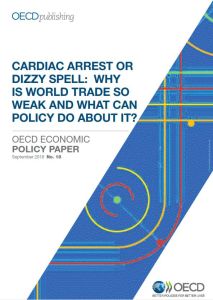Join getAbstract to access the summary!

Join getAbstract to access the summary!
David Haugh, Alexandre Kopoin, Elena Rusticelli, David Turner and Richard Dutu
Cardiac Arrest or Dizzy Spell
Why Is World Trade So Weak and What Can Policy Do About It?
OECD, 2016
What's inside?
World trade has been mired in malaise since the global financial crisis.
Recommendation
International leaders are grappling with an ideological and pragmatic clash over globalization, trade and their combined effects on the economic conditions of not only individual countries but also of the worldwide commercial architecture. Yet the current political and economic environment highlights a concern that has been brewing since the dawn of the 21st century: Trade volume has barely kept pace with global GDP growth since 2008. OECD economists dissect the specifics of the downdraft of worldwide trade and its consequences. getAbstract recommends this authoritative report on the critical elements of trade inertia to economists and corporate executives.
Summary
About the Authors
David Haugh et al. are economists at the OECD.

















Comment on this summary